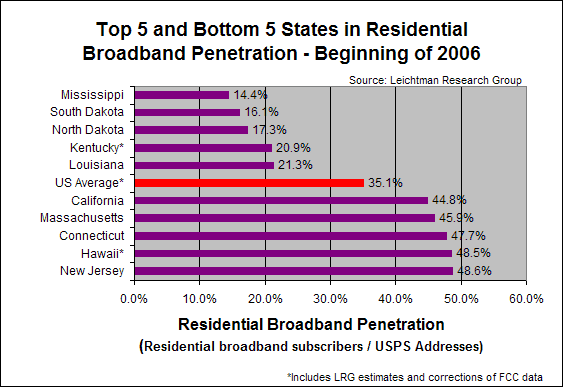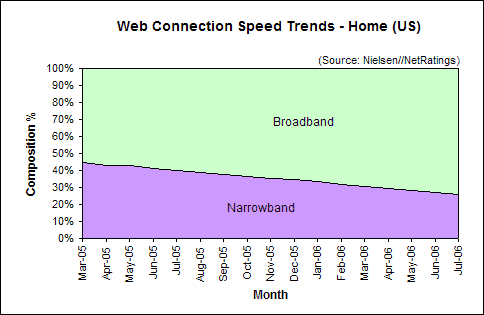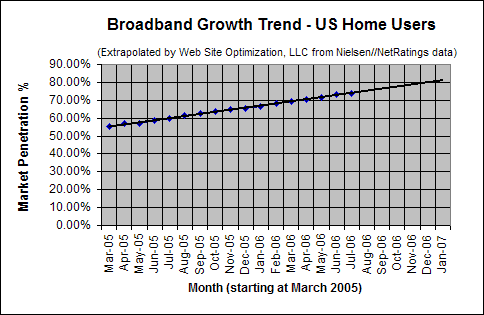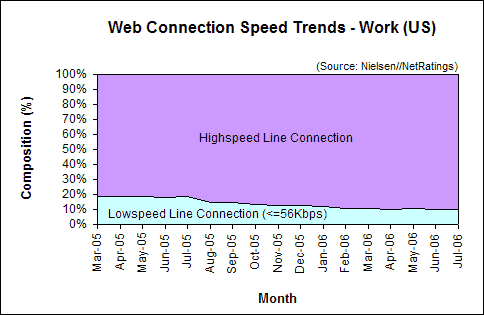New Jersey edged out Hawaii to lead all states in broadband penetration with 48.6% of NJ households subscribing to a high speed connection. Mississippi trails all states with 14.4% of households on broadband at the beginning of 2006. Meanwhile, workplace broadband penetration broke 90% for the first time in July 2006. US broadband penetration among active Internet users grew 0.76 percentage points to 73.86% in July 2006.
New Jersey Edges Hawaii in Residential Broadband Penetration
New Jersey has the highest broadband penetration rate among the fifty states at 48.6%, according to Leichtman Research Group. Hawaii was a close second at 48.5%, followed by Connecticut at 47.7%, Massachusetts at 45.9%, and California at 44.8% home broadband penetration (see Figure 1). These residential penetration rates are well above the national average of 35.1%. Mississippi trails all states with 14.4% broadband penetration, followed by South Dakota at 16.1%, North Dakota with 17.3%, Kentucky at 20.9%, and Louisiana at 21.3%. Closer to home, Michigan has a home broadband penetration rate of 32.8%, below the national average.
Top 5 and Bottom 5 States in Residential Broadband Penetration – 2006
Figure 1: Top 5 and Bottom 5 States in Residential Broadband Broadband Penetration – 2006
Source: Leichtman Research Group
Home Connectivity in the US
US broadband penetration among active Internet users grew to 73.86% in July 2006. Narrowband users connecting at 56Kbps or less now comprise 26.14% of active Internet users, down 0.76 percentage points from 26.9% in June (see Figure 2).
Web Connection Speed Trends – Home Users (US)
Figure 2: Web Connection Speed Trends – Home Users (US)
Source: Nielsen//NetRatings
Broadband Growth Trends in the US
In July 2006, broadband penetration in US homes grew 0.76 percentage points to 73.86% up from 73.1% in June. This increase of 0.76 points is below the average increase in broadband of 1.26 points per month over the last six months (see Figure 3). At current growth rates US broadband should break 80% among active Internet users by December 2006.
Broadband Adoption Growth Trend – Home Users (US)
Figure 3: Broadband Adoption Growth Trend – Home Users (US)
Extrapolated from Nielsen//NetRatings data
Work Connectivity
Workplace broadband penetration broke 90% for the first time in July. As of July 2006, 90.32% of US workers were on broadband, up 0.48 percentage points from the 89.84% share in June. At work 9.68% connect at 56Kbps or less (see Figure 4).
Web Connection Speed Trends – Work Users (US)
Figure 4: Web Connection Speed Trends – Work Users (US)
Source: Nielsen//NetRatings
US Internet Penetration
69% of U.S. households with a fixed phone line have Internet access. Nielsen//NetRatings and Leichtman Research Group’s annual broadband study both confirm this figure. Per person, 74% of people age 2+ in U.S. households with a fixed phone line have Internet access.
Further Reading
- DNS could slow broadband service
- While ISPs add bandwidth, a new study by Nominum found that slow DNS lookups could slow response times. CNET News.com, Aug. 17, 2006.
- FCC
- Local Telephone Competition and Broadband Deployment see the July 26, 2006 report.
- Leichtman Research Group
- Provided the state broadband penetration data, derived from FCC and USPS data and LRG estimates.
- Nielsen//NetRatings
- Provided the US broadband penetration data for active Internet users for the Bandwidth Report.
- Online Video Officially Goes Mainstream as YouTube.com Breaks Into the comScore Media Metrix Top 50
- Traffic to Myspace video doubled in July while YouTube broke the Media Metrix top 50 for the first time. Yahoo! Video led the pack with a 28-percent increase in visitation versus June 2006. Comscore Networks, Aug. 15, 2006.
- Retail VOIP Subscribers increase by 83% during 2005
- The number of subscribers to retail voice over IP (VoIP) services rose by 83% during 2005, from 10.3 million at the beginning of 2005 to over 18.7 million subscribers worldwide by the end of the year. Point Topic, Aug. 16, 2006.




